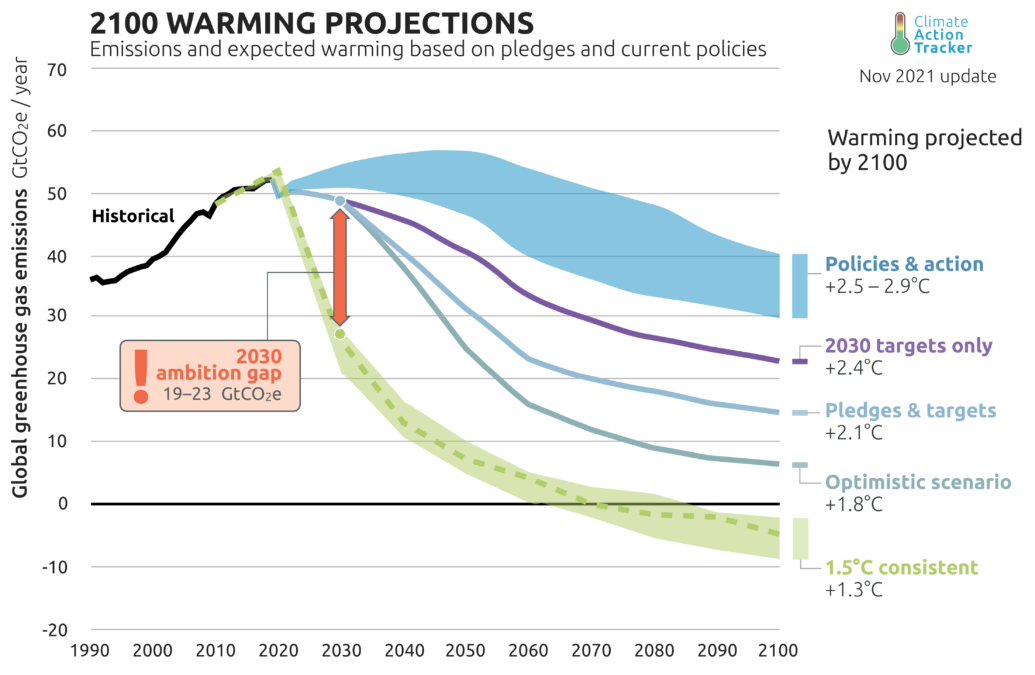Climate change – what’s in a number?
In the challenging environment of climate change information, the dilemma is which not-so-beautiful set of numbers to pay attention to (apologies to Paul Keating).
As someone who has been researching the business of climate change for many years, I find it useful to break the numbers into a handful of categories.
Warming
For many 1.5C is the main-game number
1.5C is the amount of average global warming above pre-industrial levels beyond which climate impacts become irreversible and potentially catastrophic (although it can be argued that having already warmed the planet 1.2C above pre-industrial levels we are already seeing pretty disastrous impacts regarding worsening wildfires, droughts, storms, floods, coral bleaching and biodiversity collapse!)
So, how are tracking?

According a recent analysis by Climate Action Tracker current international pledges for emissions reductions at COP26 in Glasgow have the world heading for a best case scenario of 2.4 degrees celsius of warming by the end of the century. (So not great.)
7:7: an indication of how bad things are already
7 hottest years on record have occurred in the last 7 years (NASA, 2021)
60ºC
Likely daily temperatures in the middle East and North Africa (MENA) by mid-century due to global warming – making many areas uninhabitable.
By the end of this century large parts of the planet may be too hot and humid for human thermoregulation. If current greenhouse gas projections hold, about 600 million inhabitants, or 50 percent of the MENA population, may be exposed to “super-extreme” weather events.
Drivers
Just 90 entities (large fossil fuel corporations and state-owned organisations) have been responsible for two thirds of greenhouse gas emissions (GHGs) between 1751 and 2010. Half of these GHGs were released since 1986. Indeed, 20 companies are responsible for a third of all human carbon emissions.
3
Australia is the third largest fossil fuel exporter (behind Russia and Saudi Arabia), and the largest fossil fuel exporter in the OECD, making up 7% of fossil fuel exports.
11
Australia has the 11th largest CO2 emissions per capita (ahead of the US!).
Atmospheric carbon concentrations
350.org is an NGO that advocates for fossil fuel divestment on the path to 100% renewable energy use worldwide. Its name derives from the atmospheric CO2 concentration needed for the world to return to a stable climate.
How are we doing CO2 wise?
417ppm
Current level of atmospheric CO2 at Nov 2021
280ppm
Atmospheric CO2 concentrations pre-industrial revolution
Impacts
Day Zero is the name given to the date in 2018 when the South African city of Cape Town (4 million residents) nearly ran out of drinking water due to an unprecedented drought. Such extreme events could go from being rare to common events by the end of this century.
3 billion
The number of animals killed along with the destruction of 1.8million hectares of forest and 300 homes in the 2019/20 Australian ‘Black Summer’ bushfires. According to fire historian Stephen Pyne we are living in the global fire age – the Pyrocene.
1 metre
Estimated sea-level rise by 2100 under current emissions secnarios. However, this could be an underestimate if there is a further acceleration in the collapse of the ice shelves in Greenland and Antarctica. In which case the number could be as high as several metres.
1 billion people
The number of coastal dwelling people who, by mid-century, will be impacted by rising oceans and worsening storms.
At the current rate of warming (2.1ºC- 3.5ºC) the following major cities will be flooded: Miami, New York, Shanghai, Mumbai, Jakarta and Sydney. Entire island nations, the Maldives, Seychelles, South Pacific Islands, will be obliterated.
This roulette of bad numbers is not a matter of bad luck. Every one of these numbers can be improved if we have the will to drive the political change necessary for radical decarbonisation of our economies.

Chris is Professor of Organisational Studies and leader of the Balanced Enterprise Research Network at the University of Sydney Business School. His research focuses on the diffusion of management knowledge, consultancy and organisational change.
The Future, This Week
Listen to The Future, This Week where Christopher Wright joins Sandra Peter and Kai Riemer to discuss all the numbers of climate change and what they mean from the COP26 in Glasgow.
More on climate change
More than coral: the unseen casualties of record-breaking heat on the Great Barrier Reef
Bleached coral draws our attention, but marine heat does damage to many unseen parts of these ecosystems.
An optimistic nudge can turn an investor to the green side
Can optimistic framing drive the institutional investment shift needed to address climate change?
Harvest season is also peak time for conflict in rural societies
Do harvest season spikes in agricultural income and conflict in rural Africa and Asia present an opportunity to adjust peacekeeping Read more
Food security starts with food sovereignty
The UN’s Zero Hunger goal faces challenges in West Papua, where palm oil plantations are erasing Indigenous foodways – could Read more
Making room for the rivers
When deciding if they should live with or fight the floods, Australia and many other countries can learn from the Netherlands.
Running out of water on the blue planet
How do governments close the water management gap and improve universal access to water?